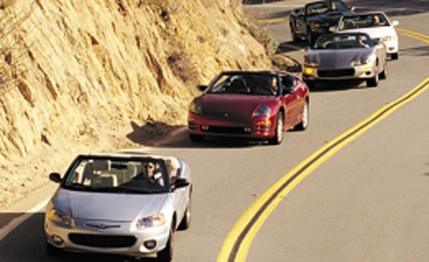
 Comparison Tests
Comparison Tests
What we really have here, friends of fresh air, is a collision of eras. Now vs. then. Contemporary vs. cretaceous. Primordial vs. polished. Power vs. sophistication. Two tests, really, in one.
On the one hand, we have a trio of contemporary convertibles -- all with V-6 power and front-wheel drive, and all quiet and mannerly. On the other hand, we have the 739th recorded renewal of a rivalry that's been going on for more than three decades: Mustang vs. Camaro.
A dichotomy wasn't the idea when we started out. With spring almost in the air (defined in Michigan as temperatures soaring above 32 degrees Fahrenheit), the idea was to round up the various four-seat convertibles available at the $30,000 edge of the luxury-price threshold and see what one gets for that kind of dough. With this end in mind, we decided to specify the best possible powerplant available within our pricing parameters. We did order automatic transmissions across the board, but even so, the engine choice had major consequences. That's because it's possible to have V-8 power with a Chevy Camaro or Ford Mustang and still keep the price under 30 large. In fact, 30 large bolts you into a Z28 version of the Camaro convertible, which also nets you better tires, more starch in the suspension, and a limited-slip rear differential. On the other hand, the $30,000 ceiling eliminated a Pontiac Firebird convertible from this group. That amount at the Pontiac store won't buy a Trans Am V-8, only a nicely equipped Firebird V-6. Suspecting that the difference between 200 horsepower (the output of the base Camaro/Firebird V-6) and 310 horsepower (from the Z28's 5.7-liter LS1 V-8) might put the Firebird at a performance disadvantage (hey, ya think?), the folks at Pontiac decided not to play.
Looking past the issue of the two design approaches vying here, we see that these ragtops do have a fair degree of commonality in the kinds of goodies baked into their prices. For example, all the tops were power-operated, and all had glass rear windows. All had air conditioning; all provided at least some measure of power adjustability to their seats; all had CD players of some sort in the standard audio gear; and all had power windows, mirrors, and locks, with remote-entry key fobs. Most of the cars had at least some leather adorning their seats, with adjustable lumbar support; the Camaro was the exception on both counts.
We put our topless quintet through a Southern California test regimen that was varied in both geography and climate, ranging from flat freeways to challenging mountain two-lanes in weather that included top-down sunshine, rain, snow, and sleet. The route ran from Los Angeles to our test venue at Willow Springs International Motorsports Park, down through Palm Springs, past the Salton Sea to Borrego Springs, then back to L.A. -- just over 700 miles total.
In the end, we found that our collective litmus test for four-seat convertibles tended to favor one particular set of characteristics over paltry considerations such as comfort. This came as no particular surprise. What was surprising, though, was how well some of the cars in this test have managed to blend comfort with driver-gratifying reflexes. So well, in fact, that the issue was in doubt right up to the final tally.